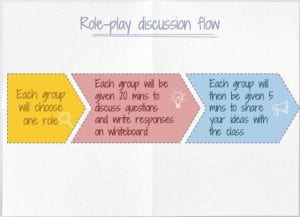SHEE Siew Ying
Department of Geography, Faculty of Arts & Social Sciences
Siew Ying shares strategies which graduate teaching assistants (GTAs) can use to create memorable learning moments for students during tutorials.

Disclaimer: The term ‘EPIC’ in the post title is not an acronym created by me; but by Professors of Business (and brothers) Chip and Dan Heath who authored The Power of Moments: Why Certain Experiences Have Extraordinary Impact. I’m using this acronym in the context of my teaching experiences.
In a module last semester, I had the opportunity to teach two tutorial groups, consisting mostly Business, Science, Engineering and Pharmacy students. It was a general education module, which means students across all departments in the National University of Singapore (NUS) have to take a module like this to fulfill their university requirements. In that module, students learned about different aspects of Singapore society through a geographical lens. Personally, I see this module as a respite for most students from their more demanding major modules; but at the same time, I don’t want them to forget the case studies and examples the moment they leave the exam halls. I hope they would learn about and engage deeply with the various social and cultural issues in Singapore society, with these knowledge and skills etched in their minds years later. However, since I only have five tutorials with them (less than ten hours in a 13-week semester), every tutorial session I have with them matters. Now, as I reflect on the tutorials that I have conducted, I thought of Chip and Dan Heath’s (2017) idea of EPIC: Elevate, Pride, Insight, and Connection, which might be useful in helping myself and fellow graduate teaching assistants (GTAs) in thinking about the ‘how’s’ of designing memorable moments in the classroom or in this context, tutorials. Despite the limited interaction time with students within a semester, we want the knowledge and skills gained from these fleeting and short tutorials to be impactful and memorable for them—not just for when they prepare for their finals but as something which will be etched in their minds even after they graduate. Tutorials need not necessarily incorporate all four EPIC elements to be memorable, but could be improved by considering any of these four aspects.
Elevate: Rise Above Everyday
Memorable moments (think of your holiday trips, birthdays, graduation ceremonies, or performances) are never mundane and boring; if anything, they are elevated moments beyond your “everyday” routine. However, what is it that would elevate these moments and make them memorable, such that you still remember them five or even ten years later (when you barely remember what you had for dinner or what you wore yesterday!)? One way to create memorable tutorials is to do something that is different from the conventional tutorial format. What is important here is not just creating a ‘different’ tutorial, but to engineer an unexpected, surprising moment for your students. In one of my tutorials, I organised a role-play activity for students while following the tutorial objectives and questions set by the module’s lecturers. In this activity, groups of students would play the role of a stakeholder and the groups would each spend 20 minutes showcasing their perspective/debating over a particular issue. The activity aimed to enhance students’ appreciation of the various stakeholders’ competing interests regarding urban planning, in particular to gain a better understanding of the complexities and difficulties of the resolution process. I had the opportunity to try this activity during the micro-teaching segment of the Teaching Assistants Programme (TAP) organised by the Centre for Development of Teaching and Learning (CDTL). Based on the feedback gathered from my classmates and the TAP facilitators, I fine-tuned the activity on my own accord by doing further research and creating more material to guide students in understanding this assigned issue. At the end of that tutorial, I distributed the feedback forms with two questions formulated to gauge students’ responses towards this activity: “What have you learned from this tutorial?”, and “What would you like to learn and do in future tutorials?”
 Excerpt from my slides
Excerpt from my slides
What I found out was, many of these students—especially those from scientific backgrounds where tutorials tend to be spent doing exercises with minimal interaction with their tutors and peers—found this activity refreshing and fun. However, having fun was not the sole objective of this activity—I wanted it to be impactful and memorable. This was when I realised that the examples they gleaned from that activity have actually remained with them even during (and hopefully beyond) the finals.
Pride: Celebrate Moments of Achievement
One of the simplest ways to transform a few minutes into a memorable moment in a student’s educational journey is to offer them recognition. I see this as an important step to affirm students—particularly freshmen who have just begun their university journey, or students taking a module outside their comfort zone. In the case of the latter, it gives them a sense of direction to gauge their progress in a new environment. Creating moments of pride for students could be as simple as paying a compliment to the entire class (such as, “I’m glad all of you have submitted your assignments on time!”), or giving written and verbal feedback to individual students (by name!), acknowledging improvements they made over time in a module. Such moments of pride are simple and at the same time, thoughtful gestures particularly for the students, as they are recognised as individuals rather than merely part of a larger class.
Insight (vs Information): Redefine Our Understanding of Ourselves and The World We Live In
Returning to the example of the role-play activity, indeed, there are other less time-consuming ways to allow students to appreciate the competing interests of various stakeholders in urban planning. I could have assigned students a reading on this topic which they have to complete before coming for tutorials and discuss during the session. I could have conducted a ‘mini-lecture’ on this topic as well, and they could (choose to) take notes. Either activity would have helped me achieve the tutorial’s learning objectives. However, these activities would not be considered as (re-)defining insight, but rather, activities which transmit a piece of information.
To produce insights thus require students to experience the process of self-discovery with the goal of redefining their previous understanding of a certain matter. It involves a dynamic learning process between the tutor and students, where tutors largely play the role of a ‘guide’ in aiding students, step by step, to understand a particular concept for themselves. Thus, producing insights is very different from simply (re)producing information. Producing information (think, for example, ‘read lecture notes page x to understand what is secularism’) is akin to providing facts from sources like Wikipedia, and expecting students to memorise them. It is a form of unidirectional ‘instructional’ teaching. In fact, the process of producing insights may take a longer time as compared to just producing information. However, the impact of this process of self-discovery is definitely more long-lasting for students, who (hopefully, eventually) get to reconstruct their previous understanding of the topic or even clarify any misconceptions on their own.
Connection: Developing positive encounters with others
Finally, the ‘C’ in creating EPIC moments concerns building connections, specifically with other people. Indeed, shared experiences are more memorable compared to those experienced alone. In a tutorial setting, this not only involves getting tutors to connect with students but also for students to connect with each other. For the latter, this is perhaps why it is important for students to form small groups during tutorials. However, simply asking students to work together during tutorials without a plan is unlikely to lead them to forge connections or create shared meaning. This is where tasks and goals, such as projects and lab assignments, become important in helping to create a shared sense of purpose among students. It is this sense of purpose that drives students to set aside whatever differences they may have and work together towards a common goal throughout the semester. Assignments and projects aside, shared moments in tutorials could also be created through simple acts such as cracking jokes or sharing personal stories and experiences, which help break the ice and enable students to connect with each other, albeit briefly, through sharing a laugh. Through developing positive encounters not just between students themselves but also with tutors, tutorials not only become more tolerable but can potentially become moments that (hopefully) they genuinely look forward to.
From these examples, we see that one needs to put much thought into creating a positive impact during tutorials, and to make them endure beyond those fleeting seconds. I hope that this post could be a starting point to (re-)consider the importance of tutorials and the role of GTAs in shaping students’ university learning journeys. Creating memorable tutorials is certainly a process that not only involves effort, but also requires the tutor to be thoughtful and purposeful.
 |
SHEE Siew Ying is currently a Master’s research student at the NUS Department of Geography, where she also obtained her Bachelor’s degree (Honours). She has tutored several undergraduate geography modules including GES1003 “Changing Landscapes of Singapore” and GE2206 “Geographies of Life and Death”. Her research interests span across a wide range of cultural and identity politics issues, with particular focus on geographies of religion, health and wellbeing. Siew Ying can be reached at siewying_@u.nus.edu. |

